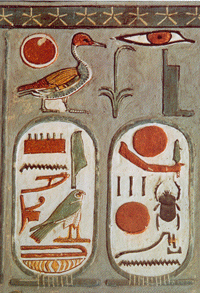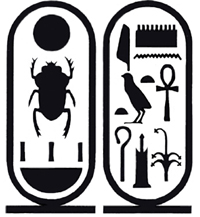 Pharaoh's
Names
Pharaoh's
Names
In this section you can learn how to read the names of pharaohs, and some other hieroglyphs that were often written with their names. Pharaoh's names (and those of their queens) were written inside a special loop called a 'cartouche'. You can see two of these cartouches in the picture left, from the tomb of Horemheb.
Nomens and Prenomens
Pharaohs had five names, but only the two most important had cartouches. There are called the nomen and prenomen. The nomen is the name the pharaoh was given when he was born - like your own first name. The nomen is the name by which we usually know a pharaoh - for example Tutankhamun or Ramses.
The prenomen is the name the pharaoh was given when he became pharaoh, and it is also sometimes known as the 'throne name'. Tutankhamun's throne name is 'Nebkheperure'. Every pharaoh's prenomen has 'Re' in it, the name of the sun god (sometimes written 'Ra'). The nomen very often has a god's name in it too. Tutankhamun was named after Amun, the king of the gods. His name is actually three words - tut-ankh-amun - which means 'Living image of Amun.'
How to work out a pharaoh's name
In the table below you can see some Egyptian words and letters. These were used to make up pharaoh's names, and to say things about them (like 'King of Upper and Lower Egypt'). Look at the table, then see if you can work out the cartouches below. (It may help to print the table below, or the whole page).

Name the Pharaoh's Name Game #1
See if you can read the names of these pharaohs. If there are two, the first is the prenomen and the second the nomen. Below are some important tips to help you. Click here for the answers, and to play a similar game, looking at photos of hieroglyphs from tomb and temple walls.
|
1.
|
|
2.
|
|
3.
|
|
5.
|
|
6.
|
|
7.
|
8.
 |
Important tips to help you work out these cartouches:
1. Look for the name of a god to help you - common ones are Re/Ra, Amun, and Thoth (usually written as Thut or Tuth in a pharaoh's name).
2. Foreign names, like Cleopatra and Ptolemy, were written with hieroglyphs for single letters. For example, Cleopatra is written c-l-i-o-p-a-t-r-a.
Egyptian names were made up of words, and sometimes letters too. For example, Tutankhamun is made up of the letters t-u-t plus the word ankh plus the god Amun. He also has some extra words at the end, heqa-iunu-shema - which we don't usually say. (This means 'ruler of Thebes').
3. The god part of a pharaoh's name is always written first, even if it is pronounced at the end. For example, in Tutankhamun, Amun is written at the start. In the prenomens, Re is always written at the start, but always pronounced at the end. For example, Tutankhamun's throne name is said 'Nebkheperure', but the Re is written at the start.
4. Sometimes a hieroglyph
can be used for two or three letter sounds - like nfr (nefer), or wsr
(user). Now and then the Egyptians would also write the last two or three
letters too, but these are not pronounced. We see this is Amenhotep's name:
hotep, ![]() , is written with the t
and the p:
, is written with the t
and the p: .
.
5. Many pharaoh names have two parts to them. It helps to divide them into these two parts. Look for the gods' names to see where the two halves are. For example, Ramses II's nomen is written with these two halves: 1. Amun mery, 2. Ramesesw. Usually we say the familiar part of the name first: Ramses Mery-Amun. Notice again that in Mery-Amun the god's name is written first in hieroglyphs, but pronounced first.
Hatshepsut's nomen has these two parts: 1. Amun khnemet, 2. Hatshepsut. Again we say the familiar name first: Hatshepsut Khnemet-Amun.
GAMES



 4.
4.




